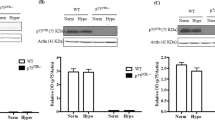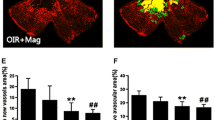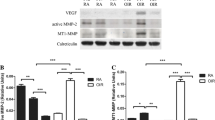Abstract
Ischemic diseases such as stroke and proliferative retinopathy are characterized by hypoxia-driven release of angiogenic factors such as vascular endothelial growth factor (VEGF). However, revascularization of the ischemic areas is inadequate, resulting in impaired neuro-vascular function. We aim to examine the vascular protective effects of candesartan, an angiotensin receptor blocker, in an ischemic retinopathy mouse model. Vascular density, number of tip cells, and perfusions of capillaries were assessed. Activation of Muller glial cells and levels of peroxynitrite, VEGF, VEGFR2, inducible nitric oxide synthase, hemeoxygenase-1 (HO-1) were assessed. Proangiogenic effects of candesartan were examined in human endothelial cells (EC) that were cultured in normoxia or hypoxia and transduced with siRNA against HO-1. Candesartan (1 mg/kg) and (10 mg/kg) decreased hypoxia-induced neovascularization by 67 and 70 %, respectively. Candesartan (10 mg/kg) significantly stimulated the number of tip cells and physiological revascularization of the central retina (45 %) compared with untreated pups. The effects of candesartan coincided with reduction of hypoxia-induced Muller glial activation, iNOS expression and restoration of HO-1 expression with no significant change in VEGF levels. In vitro, silencing HO-1 expression blunted the ability of candesartan to induce VEGF expression under normoxia and VEGFR2 activation and angiogenic response under both normoxia and hypoxia. These findings suggest that candesartan improved reparative angiogenesis and hence prevented pathological angiogenesis by modulating HO-1 and iNOS levels in ischemic retinopathy. HO-1 is required for VEGFR2 activation and proangiogenic action of candesartan in EC. Candesartan, an FDA-approved drug, could be repurposed as a potential therapeutic agent for the treatment of ischemic diseases.








Similar content being viewed by others
Abbreviations
- VEGF:
-
Vascular endothelial growth factor
- p:
-
Postnatal day
- Cand:
-
Candesartan
- ROP:
-
Retinopathy of prematurity
- DR:
-
Diabetic retinopathy
- iNOS:
-
Inducible nitric oxide synthase
- HO-1:
-
Hemeoxygenase-1
References
El-Kenawi AE, El-Remessy AB (2013) Angiogenesis inhibitors in cancer therapy: mechanistic perspective on classification and treatment rationales. Br J Pharmacol 170:712–729
Sapieha P (2012) Eyeing central neurons in vascular growth and reparative angiogenesis. Blood 120:2182–2194
Chen J, Smith LE (2007) Retinopathy of prematurity. Angiogenesis 10:133–140
Carmeliet P (2003) Angiogenesis in health and disease. Nat Med 9:653–660
Fletcher EL, Phipps JA, Ward MM, Vessey KA, Wilkinson-Berka JL (2010) The renin-angiotensin system in retinal health and disease: its influence on neurons, glia and the vasculature. Prog Retin Eye Res 29:284–311
Chua CC, Hamdy RC, Chua BH (1998) Upregulation of vascular endothelial growth factor by angiotensin II in rat heart endothelial cells. Biochim Biophys Acta 1401:187–194
Alhusban A, Kozak A, Ergul A, Fagan SC (2013) AT1 receptor antagonism is proangiogenic in the brain: BDNF a novel mediator. J Pharmacol Exp Ther 344:348–359
Willis LM, El-Remessy AB, Somanath PR, Deremer DL, Fagan SC (2011) Angiotensin receptor blockers and angiogenesis: clinical and experimental evidence. Clin Sci (Lond) 120:307–319
Kozak A, Ergul A, El-Remessy AB, Johnson MH, Machado LS et al (2009) Candesartan augments ischemia-induced proangiogenic state and results in sustained improvement after stroke. Stroke 40:1870–1876
Guan W, Somanath PR, Kozak A, Goc A, El-Remessy AB et al (2011) Vascular protection by angiotensin receptor antagonism involves differential VEGF expression in both hemispheres after experimental stroke. PLoS One 6:e24551
Soliman SA, Ishrat T, Pillai A, Somanath PR, Ergul A et al (2014) candesartan induces a prolonged proangiogenic effect and augments endothelium-mediated neuroprotection after oxygen and glucose deprivation: role of vascular endothelial growth factors A and B. J Pharmacol Exp Ther 349:444–457
Sano H, Hosokawa K, Kidoya H, Takakura N (2006) Negative regulation of VEGF-induced vascular leakage by blockade of angiotensin II type 1 receptor. Arterioscler Thromb Vasc Biol 26:2673–2680
Nagisa Y, Shintani A, Nakagawa S (2001) The angiotensin II receptor antagonist candesartan cilexetil (TCV-116) ameliorates retinal disorders in rats. Diabetologia 44:883–888
Nakamura S, Tsuruma K, Shimazawa M, Hara H (2012) Candesartan, an angiotensin II type 1 receptor antagonist, inhibits pathological retinal neovascularization by downregulating VEGF receptor-2 expression. Eur J Pharmacol 685:8–14
Sennlaub F, Courtois Y, Goureau O (2001) Inducible nitric oxide synthase mediates the change from retinal to vitreal neovascularization in ischemic retinopathy. J Clin Invest 107:717–725
Sennlaub F, Courtois Y, Goureau O (2002) Inducible nitric oxide synthase mediates retinal apoptosis in ischemic proliferative retinopathy. J Neurosci 22:3987–3993
Gu W, Weihrauch D, Tanaka K, Tessmer JP, Pagel PS et al (2003) Reactive oxygen species are critical mediators of coronary collateral development in a canine model. Am J Physiol Heart Circ Physiol 285:H1582–H1589
Zhang Q, Zhang J, Guan Y, Zhang S, Zhu C et al (2009) Suppression of retinal neovascularization by the iNOS inhibitor aminoguanidine in mice of oxygen-induced retinopathy. Graefes Arch Clin Exp Ophthalmol 247:919–927
Du AJ, Ren B, Gao XW, Yang L, Fu Y et al (2013) Effects of aminoguanidine on retinal apoptosis in mice with oxygen-induced retinopathy. Int J Ophthalmol 6:436–441
Xu Z, Gong J, Maiti D, Vong L, Wu L et al (2012) MEF2C ablation in endothelial cells reduces retinal vessel loss and suppresses pathologic retinal neovascularization in oxygen-induced retinopathy. Am J Pathol 180:2548–2560
Zhang W, Zhang X, Lu H, Matsukura M, Zhao J et al (2013) Silencing heme oxygenase-1 gene expression in retinal pigment epithelial cells inhibits proliferation, migration and tube formation of cocultured endothelial cells. Biochem Biophys Res Commun 434:492–497
Abdelsaid MA, Pillai BA, Matragoon S, Prakash R, Al-Shabrawey M et al (2010) Early intervention of tyrosine nitration prevents vaso-obliteration and neovascularization in ischemic retinopathy. J Pharmacol Exp Ther 332:125–134
Abdelsaid MA, Matragoon S, El-Remessy AB (2013) Thioredoxin-interacting protein expression is required for VEGF-mediated angiogenic signal in endothelial cells. Antioxid Redox Signal 19:2199–2212
Wei Y, Gong J, Thimmulappa RK, Kosmider B, Biswal S et al (2013) Nrf2 acts cell-autonomously in endothelium to regulate tip cell formation and vascular branching. Proc Natl Acad Sci USA 110:E3910–E3918
El-Remessy AB, Behzadian MA, Abou-Mohamed G, Franklin T, Caldwell RW et al (2003) Experimental diabetes causes breakdown of the blood-retina barrier by a mechanism involving tyrosine nitration and increases in expression of vascular endothelial growth factor and urokinase plasminogen activator receptor. Am J Pathol 162:1995–2004
Grochot-Przeczek A, Dulak J, Jozkowicz A (2010) Heme oxygenase-1 in neovascularisation: a diabetic perspective. Thromb Haemost 104:424–431
Liu XQ, Wu BJ, Pan WH, Zhang XM, Liu JH et al (2013) Resveratrol mitigates rat retinal ischemic injury: the roles of matrix metalloproteinase-9, inducible nitric oxide, and heme oxygenase-1. J Ocul Pharmacol Ther 29:33–40
Peng PH, Chao HM, Juan SH, Chen CF, Liu JH et al (2011) Pharmacological preconditioning by low dose cobalt protoporphyrin induces heme oxygenase-1 overexpression and alleviates retinal ischemia-reperfusion injury in rats. Curr Eye Res 36:238–246
Fan J, Xu G, Jiang T, Qin Y (2012) Pharmacologic induction of heme oxygenase-1 plays a protective role in diabetic retinopathy in rats. Invest Ophthalmol Vis Sci 53:6541–6556
Bussolati B, Mason JC (2006) Dual role of VEGF-induced heme-oxygenase-1 in angiogenesis. Antioxid Redox Signal 8:1153–1163
Quincozes-Santos A, Bobermin LD, Latini A, Wajner M, Souza DO et al (2013) Resveratrol protects C6 astrocyte cell line against hydrogen peroxide-induced oxidative stress through heme oxygenase 1. PLoS One 8:e64372
Rosales MA, Silva KC, Duarte DA, de Oliveira MG, de Souza GF et al (2014) S-nitrosoglutathione inhibits inducible nitric oxide synthase upregulation by redox posttranslational modification in experimental diabetic retinopathy. Invest Ophthalmol Vis Sci 55:2921–2932
Papp A, Nemeth I, Karg E, Papp E (1999) Glutathione status in retinopathy of prematurity. Free Radic Biol Med 27:738–743
Gu X, El-Remessy AB, Brooks SE, Al-Shabrawey M, Tsai NT et al (2003) Hyperoxia induces retinal vascular endothelial cell apoptosis through formation of peroxynitrite. Am J Physiol Cell Physiol 285:C546–C554
Brooks SE, Gu X, Samuel S, Marcus DM, Bartoli M et al (2001) Reduced severity of oxygen-induced retinopathy in eNOS-deficient mice. Invest Ophthalmol Vis Sci 42:222–228
El-Remessy AB, Al-Shabrawey M, Platt DH, Bartoli M, Behzadian MA et al (2007) Peroxynitrite mediates VEGF’s angiogenic signal and function via a nitration-independent mechanism in endothelial cells. FASEB J 21:2528–2539
Stevenson L, Matesanz N, Colhoun L, Edgar K, Devine A et al (2010) Reduced nitro-oxidative stress and neural cell death suggests a protective role for microglial cells in TNFalpha−/− mice in ischemic retinopathy. Invest Ophthalmol Vis Sci 51:3291–3299
DeNiro M, Al-Halafi A, Al-Mohanna FH, Alsmadi O, Al-Mohanna FA (2010) Pleiotropic effects of YC-1 selectively inhibit pathological retinal neovascularization and promote physiological revascularization in a mouse model of oxygen-induced retinopathy. Mol Pharmacol 77:348–367
Nakamura H, Yamazaki M, Ohyama T, Inoue T, Arakawa N et al (2009) Role of angiotensin II type 1 receptor on retinal vascular leakage in a rat oxygen-induced retinopathy model. Ophthalmic Res 41:210–215
Moravski CJ, Kelly DJ, Cooper ME, Gilbert RE, Bertram JF et al (2000) Retinal neovascularization is prevented by blockade of the renin–angiotensin system. Hypertension 36:1099–1104
Nagai N, Noda K, Urano T, Kubota Y, Shinoda H et al (2005) Selective suppression of pathologic, but not physiologic, retinal neovascularization by blocking the angiotensin II type 1 receptor. Invest Ophthalmol Vis Sci 46:1078–1084
Gemici B, Tan R, Ongut G, Izgut-Uysal VN (2010) Expressions of inducible nitric oxide synthase and cyclooxygenase-2 in gastric ischemia-reperfusion: role of angiotensin II. J Surg Res 161:126–133
Palaniyappan A, Uwiera RR, Idikio H, Menon V, Jugdutt C et al (2013) Attenuation of increased secretory leukocyte protease inhibitor, matricellular proteins and angiotensin II and left ventricular remodeling by candesartan and omapatrilat during healing after reperfused myocardial infarction. Mol Cell Biochem 376:175–188
Fan Q, Liao J, Kobayashi M, Yamashita M, Gu L et al (2004) Candesartan reduced advanced glycation end-products accumulation and diminished nitro-oxidative stress in type 2 diabetic KK/Ta mice. Nephrol Dial Transplant 19:3012–3020
Fletcher EL, Downie LE, Hatzopoulos K, Vessey KA, Ward MM et al (2010) The significance of neuronal and glial cell changes in the rat retina during oxygen-induced retinopathy. Doc Ophthalmol 120:67–86
Kurihara T, Ozawa Y, Shinoda K, Nagai N, Inoue M et al (2006) Neuroprotective effects of angiotensin II type 1 receptor (AT1R) blocker, telmisartan, via modulating AT1R and AT2R signaling in retinal inflammation. Invest Ophthalmol Vis Sci 47:5545–5552
Downie LE, Pianta MJ, Vingrys AJ, Wilkinson-Berka JL, Fletcher EL (2008) AT1 receptor inhibition prevents astrocyte degeneration and restores vascular growth in oxygen-induced retinopathy. Glia 56:1076–1090
Palmer LA, Semenza GL, Stoler MH, Johns RA (1998) Hypoxia induces type II NOS gene expression in pulmonary artery endothelial cells via HIF-1. Am J Physiol 274:L212–L219
Acknowledgments
The authors would like to thank Astra-Zeneca for providing candesartan. Authors are indebted to Megan L. Bartasis for providing help with Western blot. This work was supported by grants from EY-022408, JDRF (2-2008-149) and Culver Vision Discovery Institute to ABE, postdoctoral Fellowship from Islamic Development Bank to M.F.E., predoctoral fellowship (12PRE12030197) from American Heart Association for S.S., VA Merit award (BX000891) to S.C.F.
Conflict of interest
The authors have nothing to disclose. The contents do not represent the views of the Department of Veterans Affairs or the United States government.
Author information
Authors and Affiliations
Corresponding author
Electronic supplementary material
Below is the link to the electronic supplementary material.
Rights and permissions
About this article
Cite this article
Shanab, A.Y., Elshaer, S.L., El-Azab, M.F. et al. Candesartan stimulates reparative angiogenesis in ischemic retinopathy model: role of hemeoxygenase-1 (HO-1). Angiogenesis 18, 137–150 (2015). https://doi.org/10.1007/s10456-014-9451-4
Received:
Accepted:
Published:
Issue Date:
DOI: https://doi.org/10.1007/s10456-014-9451-4




